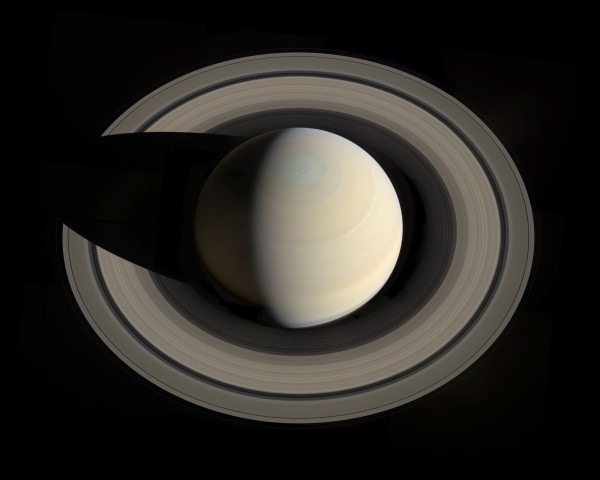[Click HERE to enlarge]
SLATE: Saturn is so beautiful that it would be next to impossible to pick what would be my favorite picture of it ever. Impossible until now. Because HOLY HALEAKALA Croatian software developer and “amateur” astronomical image processor Gordan Ugarkovic has created a picture of Saturn so stunning words fail me. Look. I had to shrink the original 4000 x 3200 pixel behemoth to fit this blog. So please, click that picture to see it in full resolution. It’s staggering. OK, you should know by now that words never fail me. Let me take you on a journey, one that’s 1.6 billion kilometers long…On Oct. 10, 2013, Cassini took 36 shots of Saturn, a dozen each using red, green, and blue filters which approximate true color. Ugarkovic grabbed the raw files, processed them, and assembled them into this mosaic. The detail is incredible. Cassini was high above Saturn to the north, looking “down” on the ringed world when it took these images. You can see the bizarre hexagonal north polar vortex, the six-sided jet stream flowing around Saturn. The subtle but beautiful bands mark the cloud tops of Saturn’s atmosphere. Unless I’m mistaken, the thin white line you see wrapping around the planet at mid-latitude is the remnant of a vast storm so huge it completely dwarfed our own home world of Earth. MORE
RELATED: Saturnalia was an ancient Roman festival in honour of the deity Saturn held on December 17 of the Julian calendar and later expanded with festivities through December 23. The holiday was celebrated with a sacrifice at the Temple of Saturn in the Roman Forum and a public banquet, followed by private gift-giving, continual partying, and a carnival atmosphere that overturned Roman social norms: gambling was permitted, and masters provided table service for their slaves.[1] The poet Catullus called it “the best of days.”[2] In Roman mythology, Saturn was an agricultural deity who reigned over the world in the Golden Age, when humans enjoyed the spontaneous bounty of the earth without labor in a state of social egalitarianism. The revelries of Saturnalia were supposed to reflect the conditions of the lost mythical age, not all of them desirable. A number of scholars, including historian David Stephens from the University of Central Florida and Professor Parker-Ducharme from Tulane University view aspects of the Saturnalia festival as the origin of some later Christmas customs, particularly the practice of gift giving, which was suppressed by the Catholic Church during the Middle Ages.[92] MORE

